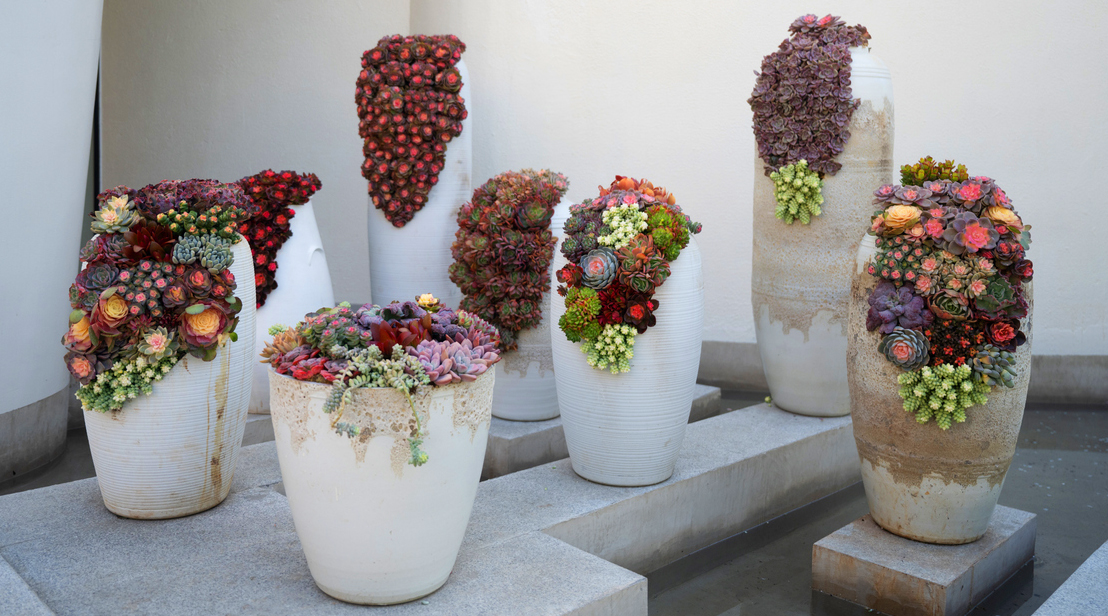
How to arrange plants in pots
But, great-looking pots don’t just happen; they are carefully thought-out and designed, just like putting together a favorite outfit. Try to think of dressing your pots as you would dress yourself. The suit you select is your foundation to the outfit, just as the pot is to your design. The blouse, jewelry, scarf, etc. will be chosen to match the suit. The point here is that everything should be linked somehow. They don’t need to be the same, or match specifically, but simply need to coordinate. All too often, people just put in plants that they like without considering how they all work together.
Designing Starts With The Pots
Whether terra cotta, plastic, metal, or concrete, pots are not like a pair of jeans; they really don’t go with everything. Pots are the influencing factor in your design. They set the theme. The color, texture and style of the pot should dictate what goes in it. For that reason I always recommend people take their pots with them to the garden center. Try to pick plants that coordinate with the pot’s design and color. For instance, a finely quaffed dwarf evergreen is not going to look good in a campy, pink animal shaped container, but floppy pansies or petunias would. Pick your pot, and then select one favorite plant. Surround it with others that have a common thread of color that beautifully weaves them together.
Also remember these three elements: thrillers, chillers, and spillers. The ”thriller” is the focal point, the tallest plant. As a general rule of thumb, the thriller should be about two-thirds taller than the container itself. ”Chillers” are plants that fill the space between the base of the pot and the thriller. They are upright and grow shorter than the thriller. ”Spillers” anchor the pot and spill over the edge of the container, softening the look. They fill the foundation of the pot. Select petunias, ivy geraniums, or an airy asparagus fern. Here is a killer combo of plants that do their job grabbing the center stage for attention:
Lemon Breeze
The sun always shines around a happy pot with personality. Start with yellow flowering maple (Abutilion). This ”THRILLER” provides height and is showered with delicate drooping yellow tissue-like buttercup flowers which bloom all season. The ”CHILLER,” ‘Wild Rumpus’ (Juncus Effusus) wired nature will add contrast to the softness of the flowering maple. It adds whimsical flair with the same green color that is woven throughout the combination. Vinca vine becomes a ”SPILLER” as it softens the container and draws the eye down the pot. The creamy, nearly yellow foliage is a reflection of the yellow flowers. Yellow-green Asparagus fern (Sprengeri densiflorus) is another ”CHILLER” that mimics the color and delicate nature of the flowering maple and adds an anchor to the base of the collection.
For added interest, white and green caladium under the canopy of the abutilon adds a sense of calm and style.
LIGHT: Full Sun
Succulents and thyme, together, create an architectural gem, an awesome pairing that works in any climate, but definitely has a southwest, contemporary flair. The soft pastel colors give it a delicate edge. The funky succulents make this pot a conversation piece. All the plants play off one another. A fabulous succulent that is as interesting as it is beautiful is “Iceberg” (sedum reflexum). It adds a contrast in texture and gracefully drips over the side. The variegated, soft, silvery, green thyme blends beautifully with pastel colors in the succulents. Its petite leaves offer balance to the large succulent leaves. “Sweet Caroline” Bronze ipomoea softens the arrangement while its burgundy color contrasts well with the potted arrangement.
TIP: Shop with your Pot!
Bring your pot when selecting flowers. That way you’ll be able to get a sense as to whether the pot and flower combo work together.
Feeding: Remember that pots do not have the ability to spread their roots into the native soil, which means you need to feed them regularly. I like to use Dr. Earth® because it is organic and breaks down slowly. This way, I don’t have to constantly feed my plants every other week.
Rebecca Kolls
Note: Rebecca Kolls is a friend of ours at Dr. Earth® and the very talented host of the nationally syndicated show ”Rebecca’s Garden,” and Gardening and Lifestyles editor for ”Good Morning America.” She now publishes her own magazine called ”Seasons by Rebecca” at www.rebeccakolls.com. I encourage all gardeners to visit her website for excellent information.





